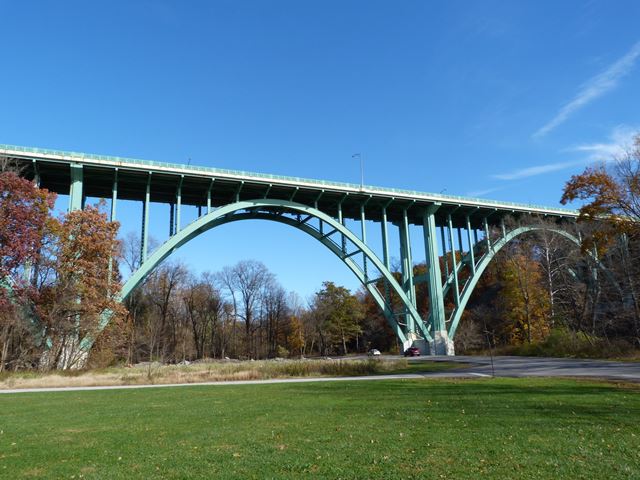We Recommend:
Bach Steel - Experts at historic truss bridge restoration.
BridgeHunter.com Phase 1 is released to the public! - Visit Now
Lorain Road Viaduct

Primary Photographer(s): Nathan Holth
Bridge Documented: November 11, 2015
Fairview Park: Cuyahoga County, Ohio: United States
Metal 13 Panel Two-Hinged Solid Ribbed Deck Arch, Fixed and Approach Spans: Metal Stringer (Multi-Beam), Fixed
1935 By Builder/Contractor: Fort Pitt Bridge Works of Pittsburgh, Pennsylvania and Engineer/Design: D. H. Overman and Ohio State Highway Department
1990
256.0 Feet (78 Meters)
1,230.0 Feet (374.9 Meters)
52.2 Feet (15.91 Meters)
4 Main Span(s) and 5 Approach Span(s)
1801325

View Information About HSR Ratings
Bridge Documentation
View Archived National Bridge Inventory Report - Has Additional Details and Evaluation
View Historical Article About This Bridge

This bridge is a long and impressive multi-span steel deck arch bridge. An uncommon bridge type, steel deck arch bridges are typically utilized in between steep canyons, and so are in many cases single span, making this multi-span example over a broad river valley even more unusual. The bridge was also technologically noteworthy when built as it used welds in areas where rivets had traditionally been used. Rivets are still in many places on this bridge, but the use of welds in some areas was groundbreaking at the time. The bridge was designed with a nod to Art Deco style architecture. Some of this has been altered when the deck was widened, but the design of the railing and pillars remain to display this architectural influence.
Above: Historical photo showing bridge construction.
Above: Historical photo showing original deck layout.

Above: Historical photo showing previous bridge at this location.
Information and Findings From Ohio's Historic Bridge InventorySetting/Context The bridge carries a striped, 4-lane arterial street over a park and the picturesque Rocky River valley and Metroparks' Rocky River Reservation. Physical Description The two-hinge steel deck arch bridge has four spans of 237' to 256'-long. The end spans are asymmetrical. The two arch ribs are plate girders composed of 34'-long segments with butt-welded joints. Particular attention was paid to the detailing, including the pattern of the overlapping plates and the rivet heads. Such detail is remarkable. The original depth of the deck section cantilever has been significantly increased. Integrity Rehabilitated, 1988-90. The cantilevered deck section has been significantly increased in the mid-1980s. This resulted in the elimination of the original pylons that accented the railings and added scale tat the roadway level. Modern drainage pipes mar original aesthetics. Summary of Significance The 1935 Lorain Road Viaduct is a technologically significant example of a two-hinge steel arch. The use of butt-welding cut down significantly on the use of rivets in the bridge's design and was considered among its most technologically significant features since it was an early use of welding in a major long-span bridge in the nation and by the Ohio State Highway Department. Cleveland's Lincoln Electric Co., a major promoter and manufacturer of arc welding equipment, assisted the Ohio state highway department's bridge bureau with the design. Built by the Lowensohn Construction Co. and the Ft. Pitt Bridge Works. It was selected as the most beautiful steel bridge in its category by the American Institute of Steel Construction in 1935, a well-deserved recognition. It remains one of the most important aesthetic bridges in the state and region. Justification This is the finest example of its type and design in the state and region. Bridge Considered Historic By Survey: Yes |
![]()
Photo Galleries and Videos: Lorain Road Viaduct
Bridge Photo-Documentation
Original / Full Size PhotosA collection of overview and detail photos. This gallery offers photos in the highest available resolution and file size in a touch-friendly popup viewer.
Alternatively, Browse Without Using Viewer
![]()
Bridge Photo-Documentation
Mobile Optimized PhotosA collection of overview and detail photos. This gallery features data-friendly, fast-loading photos in a touch-friendly popup viewer.
Alternatively, Browse Without Using Viewer
![]()
Maps and Links: Lorain Road Viaduct
Coordinates (Latitude, Longitude):
Search For Additional Bridge Listings:
Bridgehunter.com: View listed bridges within 0.5 miles (0.8 kilometers) of this bridge.
Bridgehunter.com: View listed bridges within 10 miles (16 kilometers) of this bridge.
Additional Maps:
Google Streetview (If Available)
GeoHack (Additional Links and Coordinates)
Apple Maps (Via DuckDuckGo Search)
Apple Maps (Apple devices only)
Android: Open Location In Your Map or GPS App
Flickr Gallery (Find Nearby Photos)
Wikimedia Commons (Find Nearby Photos)
Directions Via Sygic For Android
Directions Via Sygic For iOS and Android Dolphin Browser
USGS National Map (United States Only)
Historical USGS Topo Maps (United States Only)
Historic Aerials (United States Only)
CalTopo Maps (United States Only)



